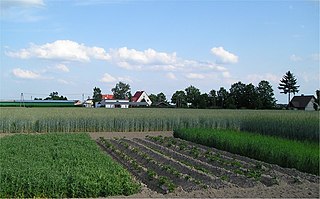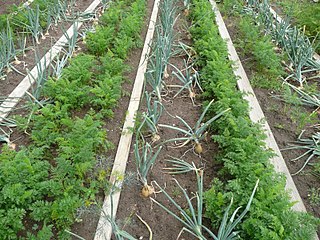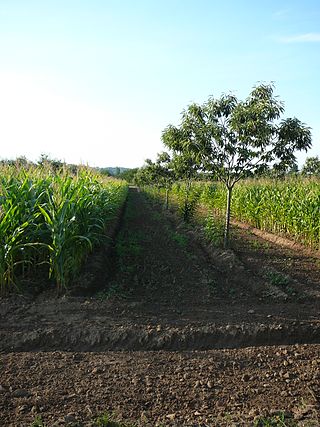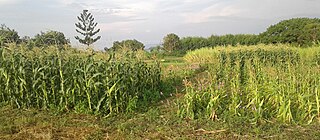
Crop rotation is the practice of growing a series of different types of crops in the same area across a sequence of growing seasons. This practice reduces the reliance of crops on one set of nutrients, pest and weed pressure, along with the probability of developing resistant pests and weeds.

In agriculture, monoculture is the practice of growing one crop species in a field at a time. Monoculture is widely used in intensive farming and in organic farming: both a 1,000-hectare cornfield and a 10-ha field of organic kale are monocultures. Monoculture of crops has allowed farmers to increase efficiency in planting, managing, and harvesting, mainly by facilitating the use of machinery in these operations, but monocultures can also increase the risk of diseases or pest outbreaks. This practice is particularly common in industrialized nations worldwide. Diversity can be added both in time, as with a crop rotation or sequence, or in space, with a polyculture or intercropping.

Organic farming, also known as ecological farming or biological farming, is an agricultural system that uses fertilizers of organic origin such as compost manure, green manure, and bone meal and places emphasis on techniques such as crop rotation and companion planting. It originated early in the 20th century in reaction to rapidly changing farming practices. Certified organic agriculture accounts for 70 million hectares globally, with over half of that total in Australia. Biological pest control, mixed cropping, and the fostering of insect predators are encouraged. Organic standards are designed to allow the use of naturally-occurring substances while prohibiting or strictly limiting synthetic substances. For instance, naturally-occurring pesticides such as pyrethrin are permitted, while synthetic fertilizers and pesticides are generally prohibited. Synthetic substances that are allowed include, for example, copper sulfate, elemental sulfur, and veterinary drugs. Genetically modified organisms, nanomaterials, human sewage sludge, plant growth regulators, hormones, and antibiotic use in livestock husbandry are prohibited. Organic farming advocates claim advantages in sustainability, openness, self-sufficiency, autonomy and independence, health, food security, and food safety.

Companion planting in gardening and agriculture is the planting of different crops in proximity for any of a number of different reasons, including weed suppression, pest control, pollination, providing habitat for beneficial insects, maximizing use of space, and to otherwise increase crop productivity. Companion planting is a form of polyculture.

Intensive agriculture, also known as intensive farming, conventional, or industrial agriculture, is a type of agriculture, both of crop plants and of animals, with higher levels of input and output per unit of agricultural land area. It is characterized by a low fallow ratio, higher use of inputs such as capital, labour, agrochemicals and water, and higher crop yields per unit land area.

Sustainable agriculture is farming in sustainable ways meeting society's present food and textile needs, without compromising the ability for current or future generations to meet their needs. It can be based on an understanding of ecosystem services. There are many methods to increase the sustainability of agriculture. When developing agriculture within sustainable food systems, it is important to develop flexible business process and farming practices. Agriculture has an enormous environmental footprint, playing a significant role in causing climate change, water scarcity, water pollution, land degradation, deforestation and other processes; it is simultaneously causing environmental changes and being impacted by these changes. Sustainable agriculture consists of environment friendly methods of farming that allow the production of crops or livestock without damage to human or natural systems. It involves preventing adverse effects to soil, water, biodiversity, surrounding or downstream resources—as well as to those working or living on the farm or in neighboring areas. Elements of sustainable agriculture can include permaculture, agroforestry, mixed farming, multiple cropping, and crop rotation.

In agriculture, cover crops are plants that are planted to cover the soil rather than for the purpose of being harvested. Cover crops manage soil erosion, soil fertility, soil quality, water, weeds, pests, diseases, biodiversity and wildlife in an agroecosystem—an ecological system managed and shaped by humans. Cover crops can increase microbial activity in the soil, which has a positive effect on nitrogen availability, nitrogen uptake in target crops, and crop yields. Cover crops may be an off-season crop planted after harvesting the cash crop. Cover crops are nurse crops in that they increase the survival of the main crop being harvested, and are often grown over the winter. In the United States, cover cropping may cost as much as $35 per acre.

In agriculture, polyculture is the practice of growing more than one crop species together in the same place at the same time, in contrast to monoculture, which had become the dominant approach in developed countries by 1950. Traditional examples include the intercropping of the three sisters, namely maize, beans, and squashes, by indigenous peoples of Central and North America, the rice-fish systems of Asia, and the complex mixed cropping systems of Nigeria.

Vigna subterranea is a member of the family Fabaceae. Its name is derived from the Bambara tribe. The plant originated in West Africa. As a food and source of income, the Bambara groundnut is considered to be the third most important leguminous crop in those African countries where it is grown, after peanut and cowpea. The crop is mainly cultivated, sold and processed by women, and is, thus, particularly valuable for female subsistence farmers.

Agroforestry is a land use management system in which combinations of trees or shrubs are grown around or among crops or pastureland. Agroforestry combines agricultural and forestry technologies to create more diverse, productive, profitable, healthy, and sustainable land-use systems. There are many benefits to agroforestry such as increasing farm profitability. In addition, agroforestry helps to preserve and protect natural resources such as controlling soil erosions, creating habitat for the wildlife, and managing animal waste. Benefits also include increased biodiversity, improved soil structure and health, reduced erosion, and carbon sequestration.
In agriculture, monocropping is the practice of growing a single crop year after year on the same land. Maize, soybeans, and wheat are three common crops often monocropped. Monocropping is also referred to as continuous cropping, as in "continuous corn." Monocropping allows for farmers to have consistent crops throughout their entire farm. They can plant only the most profitable crop, use the same seed, pest control, machinery, and growing method on their entire farm, which may increase overall farm profitability.

Organic horticulture is the science and art of growing fruits, vegetables, flowers, or ornamental plants by following the essential principles of organic agriculture in soil building and conservation, pest management, and heirloom variety preservation.

Worldwide more human beings gain their livelihood from agriculture than any other endeavor; the majority are self-employed subsistence farmers living in the tropics. While growing food for local consumption is the core of tropical agriculture, cash crops are also included in the definition.

Push–pull technology is an intercropping strategy for controlling agricultural pests by using repellent "push" plants and trap "pull" plants. For example, cereal crops like maize or sorghum are often infested by stem borers. Grasses planted around the perimeter of the crop attract and trap the pests, whereas other plants, like Desmodium, planted between the rows of maize, repel the pests and control the parasitic plant Striga. Push–pull technology was developed at the International Centre of Insect Physiology and Ecology (ICIPE) in Kenya in collaboration with Rothamsted Research, UK. and national partners. This technology has been taught to smallholder farmers through collaborations with universities, NGOs and national research organizations.

A beneficial weed is an invasive plant that has some companion plant effect, is edible, contributes to soil health, adds ornamental value, or is otherwise beneficial. These plants are normally not domesticated. However, some invasive plants, such as dandelions, are commercially cultivated, in addition to growing in the wild. Beneficial weeds include many wildflowers, as well as other weeds that are commonly removed or poisoned. Certain weeds that have obnoxious and destructive qualities have been shown to fight illness and are thus used in medicine. For example, Parthenium hysterophorus, native to northern Mexico and parts of the US, has been an issue for years due to its toxicity and ability to spread rapidly. In the past few decades, though, research has found that P. hysterophorus was "used in traditional medicine to treat inflammation, pain, fever, and diseases like malaria dysentery." It is also known to create biogas that can be used as a bioremediation agent to break down heavy metals and other pollutants.
A trap crop is a plant that attracts agricultural pests, usually insects, away from nearby target crops. This form of companion planting can save a target crop from decimation by pests without the use of artificial pesticides. A trap crop is used for attracting the insect and pests away from a target crop field. Many trap crops have successfully diverted pests from focal crops in small scale greenhouse, garden and field experiments; a small portion of these plants have been shown to reduce pest damage at larger commercial scales. A common explanation for reported trap cropping failures, is that attractive trap plants only protect nearby plants if the insects do not move back into the target crop. In a review of 100 trap cropping examples in 2006, only 10 trap crops were classified as successful at a commercial scale, and in all successful cases, trap cropping was supplemented with management practices that specifically limited insect dispersal from the trap crop back into the target crop.

Agricultural pollution refers to biotic and abiotic byproducts of farming practices that result in contamination or degradation of the environment and surrounding ecosystems, and/or cause injury to humans and their economic interests. The pollution may come from a variety of sources, ranging from point source water pollution to more diffuse, landscape-level causes, also known as non-point source pollution and air pollution. Once in the environment these pollutants can have both direct effects in surrounding ecosystems, i.e. killing local wildlife or contaminating drinking water, and downstream effects such as dead zones caused by agricultural runoff is concentrated in large water bodies.

Tephrosia vogelii, the Vogel's tephrosia, fish-poison-bean or Vogel tephrosia (English), tefrósia (Portuguese) or barbasco guineano (Spanish), is a flowering plant species in the genus Tephrosia.

Busseola fusca is a species of moth that is also known as the maize stalk borer. It is known from Ethiopia.




















